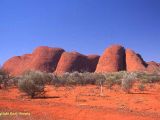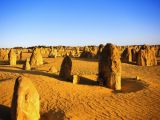In Central Australia, at the eastern edge of the Gibson Desert, there is a sandstone horst, Ayers Rock, appreciated to be "the world's largest rock", rising 348 m (1,142 ft) over the desert plateau (its maximum height is of 863 m (2,831 ft)), with a circumference of 9.4 km (5.8 mi).
This is what erosion left from an ancient mountain. It has many springs, waterholes, rock caves and ancient paintings, being listed as a World Heritage Site for its natural and man-made attributes. Also called Uluru, the rock is sacred to the Pitjantjatjara and Yankunytjatjara, the Aboriginal people of the area.
Mount Olga, located 25 km to the west, is a group of such smaller monoliths, which occupy a surface of 21.7 square km. At the highest point, Mount Olga is 1066 m above sea level, or approximately 546 m above the surrounding plain. It is composed of conglomerate, a sedimentary rock consisting of cobbles and boulders of varying rock types including granite and basalt, cemented by a matrix of sandstone.
All these rocks offer in the sunlight special visual effects and change color as the different light strikes them at different times of the day and year, glowing red on the sunset. During wet periods the Ayers Rock acquires a silvery-grey color, with streaks of black algae forming on the areas that serve as channels for water flow.
They are located at 335 km (208 mi) west of Alice Springs, the closest city.
In this areal there's a typical vegetation made of desert oak (Acacia coriacea), ironwood (Casuarina equisetifolia), bloodwood (Corymbia opaca), Spinifex grass, while the fauna is represented by kangaroos, wallabies, dingo, emu and many other marsupials.
The Pinnacles Desert is included in Nambung National Park (Western Australia), near the town of Cervantes, and 300 km of Perth. From the yellow-orange sand of the desert thousands of "pinnacles" gush. Some are 3.5 m (12 ft) tall, others are as big as a digit.
The Pinnacles are limestone formations, eroded by wind in interesting shapes, being golden-yellow, lined with white, pink, purple or brown.
Some are smooth, other are rugged. The raw material for the limestone of the Pinnacles came from seashells in an earlier epoch rich in marine life, during the Ice Age, when the seabed nearby was greatly exposed. These shells were broken down into lime rich sands which were carried inland by wind to form high mobile dunes.
Due to a wetter climate, the vegetation was stimulated, fixing the dunes, and giving the yellow-golden color. The Pinnacles were formed from lime leaching from the sand and by rain cementing the lower levels of the dune into a soft limestone.
Vegetation forms an acidic layer of soil and humus. A hard cap of calcrete developed above the softer limestone. Cracks in the calcrete were exploited by plant roots.
The softer limestone continued to dissolve and quartz sand filled the channels.
Centuries ago, another "wave" of sand carried by the wind suffocated the vegetation. Without it, the sand loosened and was blown away by the wind, revealing the lime pinnacles.

 14 DAY TRIAL //
14 DAY TRIAL // 

